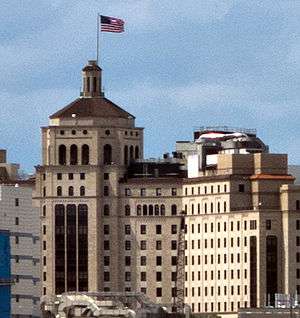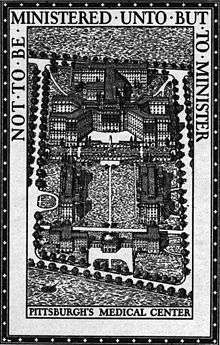UPMC Presbyterian
UPMC Presbyterian, nicknamed Presby, is a 900-bed[1] non-profit,[2][3] public, research and academic hospital located in the Oakland neighborhood of Pittsburgh, Pennsylvania, providing tertiary care for the Western Pennsylvania region and beyond. It comprises the Presbyterian campus of the combined UPMC Presbyterian Shadyside hospital entity. The medical center is a part of the University of Pittsburgh Medical Center health system and is the flagship hospital of the system.[4] UPMC Presbyterian is affiliated with the University of Pittsburgh School of Medicine and is physically conjoined to the medical school's primary facility, Scaife Hall.[5][6] UPMC Presbyterian is also connected via pedestrian bridges and tunnels to UPMC Montefiore hospital, UPMC Western Psychiatric Hospital, the Eye & Ear Institute, Falk Clinic, the University of Pittsburgh School of Nursing's Victoria Hall, the University of Pittsburgh's Lothrop Hall student residence, and multiple university biomedical science towers.[7][8][9] UPMC Presbyterian also features a Level 1 Trauma Center, 1 of 3 in Pittsburgh.[10][11]
| UPMC Presbyterian | |
|---|---|
| University of Pittsburgh Medical Center | |
 UPMC's flagship facility, UPMC Presbyterian | |

| |
| Geography | |
| Location | Pittsburgh, Pennsylvania, United States |
| Coordinates | 40.442776°N 79.960720°W |
| Organization | |
| Funding | Non-profit hospital |
| Type | Teaching |
| Affiliated university | University of Pittsburgh School of Medicine |
| Services | |
| Emergency department | Level 1 Trauma Center |
| Beds | 900 |
| Helipad | FAA LID: PS78 |
| History | |
| Opened | 1893 |
| Links | |
| Website | UPMC Presbyterian Website |
| Lists | Hospitals in Pennsylvania |


History
UPMC Presbyterian was founded in 1893 by Louise Wotring Lyle, the wife of Presbyterian minister Joseph Lyle.[12][13] Already having worked out informal agreements for teaching and staffing privileges with a number of local hospitals,[14] Pitt and its School of Medicine desired to establish an academic medical center, and by the mid-1920s had formed a plan with a coalition of city hospitals to have them relocate to the Oakland neighborhood of the city that the university had itself moved to in 1909.[15][16][17] The University provided Presbyterian Hospital, then located on the North Side, with a tract of land on its campus for construction of a new hospital which broke ground in 1930 and was subsequently opened in 1938.[18]
On November 1, 1926, Children’s became the first hospital in the Oakland neighborhood on the campus of the University of Pittsburgh.[19]
In 1938, the new Presbyterian Hospital campus joined the Children's hospital in the Oakland neighborhood campus with the objective of providing health care and providing medical education to students of the University of Pittsburgh.[20]
In 1947, Jonas Salk took a job at the University of Pittsburgh as an associate professor of bacteriology and the head of the Virus Research Lab.[21] While at Pitt, he began research on polio and the process of developing a vaccination.[22] In 1952 Salk had created the first Polio vaccination. Salk went on CBS radio to report a successful test on a small group of adults and children on 26 March 1953 and two days later, the results were published in The Journal of the American Medical Association.[23]
In the 1970's, the name of the hospital was changed to Presbyterian University Hospital. In 1986, Presbyterian merged with the nearby Montefiore Hospital to create the University of Pittsburgh Medical Center, later changing the name to UPMC Presbyterian.[24][25]
In January 1986, the nearby Children's Hospital opened up a new $250 million tower that featured 210 pediatric beds and included a two-level underground parking garage and a helipad shared by Presbyterian and Children's on the top of the tower.
The old Children's Hospital location was closed on May 2, 2009 when the hospital moved to the new location in the Lawrenceville neighborhood.[26] The original building was demolished in 2011 and the main tower with the helipad remained standing until the helipad and laboratories could move over to the Presbyterian building in 2013.[27][28]
In September 2018, UPMC unveiled plans to create the new 900,000 square-foot UPMC Heart and Transplant Hospital at UPMC Presbyterian on the site of the former Children's Hospital.[29][30] The new 18-story inpatient building is projected to open in 2023 and will include 620 private patient rooms.[31][32]
Awards
In 2011, the hospital was listed among Becker's Hospital Review 50 Best Hospitals in America,[33]
In 2019, UPMC Presbyterian received an A grade from The Leapfrog Group’s Fall 2019 Hospital Safety Grade.[34][35]
As of 2020, UPMC Presbyterian has placed nationally in 11 ranked specialties and is "high performing" in 3 specialties on the U.S. News and World Report.[36]
In the 2019-20 Best Hospitals Honor Roll, UPMC Presbyterian ranked as the 15 best hospital in the United States.[37][38]
| Specialty | Rank (In the U.S.) | Score (Out of 100) |
|---|---|---|
| Cancer | #7 | 71.4 |
| Cardiology & Heart Surgery | #33 | 56.6 |
| Diabetes & Endocrinology | #33 | 59.6 |
| Ear, Nose & Throat | #25 | 69.2 |
| Gastroenterology & GI Surgery | #8 | 71.0 |
| Geriatrics | #13 | 86.0 |
| Nephrology | High Performing | 51.6 |
| Neurology & Neurosurgery | #23 | 66.2 |
| Ophthalmology | Not Ranked | 1.1 |
| Orthopedics | #29 | 53.7 |
| Psychiatry | High Performing | 3.1 |
| Pulmonology & Lung Surgery | #18 | 77.3 |
| Rehabilitation | #12 | 5.0 |
| Rheumatology | High Performing | 4.2 |
| Urology | #16 | 70.3 |
Controversy
In 2017 it was discovered that five patients have died from mold infections since October 2014. An investigation into the deaths revealed that mold was found in linens on patient beds. These linens were found to have come from Paris Healthcare Linens, UPMC's linen provider.[40] UPMC then hired investigators to test hospital sites and Paris Linen facilities.[41] The mold was found in all areas of Paris and found on linens at UPMC Presbyterian. Multiple wrongful death lawsuits were filed against the hospital and UPMC has settled in few of them.[42] UPMC continues to contract with Paris in 22 out of 25 of their hospitals.[43][44] Paris was also implicated in the lawsuits and has settles out of court with the plaintiffs.[45]
Notable faculty
See also
References
- "PACCM Hospitals | Department of Medicine". Retrieved 2020-03-30.
- "Charitable enough? UPMC case highlights increased scrutiny of nonprofit hospitals". Healthcare Dive. Retrieved 2020-03-30.
- Johnson, Carolyn (7 February 2019). "Giant hospital system's charity status challenged". Washington Post. Retrieved 2020-03-30.
- "The UPMC Story". UPMC | Life Changing Medicine. Retrieved 2020-04-03.
- "About UPMC | Admissions & Financial Aid | University of Pittsburgh". www.medadmissions.pitt.edu. Retrieved 2020-04-03.
- Steele, Bruce (1997-05-01). "Pitt, UPMCD, UPMCS: Keeping it all straight is difficult". University Times. Retrieved 2008-09-01.
- "Crossing the Bridge" (PDF). UPMC. 2009. Retrieved April 4, 2020.
- "Sleep and Behavioral Neuroscience Center: SBNC". University of Pittsburgh Sleep & Behavioral Neuroscience Center. Retrieved April 4, 2020.
- Bauder, Bob (March 24, 2020). "Amid coronavirus pandemic, Pitt opens its dorms for doctors and nurses". Pittsburgh Tribune-Review. Retrieved April 4, 2020.
- "PA Trauma Systems Foundation". ptsf.org. Retrieved 2020-03-30.
- "Fact Sheet: Facts About Pennsylvania's Trauma Centers - Resource Center". www.haponline.org. Retrieved 2020-03-30.
- "History of UPMC Presbyterian". UPMC | Life Changing Medicine. Retrieved 2020-03-30.
- Brignano, Mary (1 November 2009). Beyond the Bounds: A History of UPMC. Dorrance Publishing. ISBN 978-1-4349-0283-2.
- Alberts, Roberts C. (1986). Pitt: The Story of the University of Pittsburgh, 1787–1987. University of Pittsburgh Press. p. 430. ISBN 978-0-8229-1150-0. Retrieved 2011-07-17.
- KIESTER Jr., EDWIN (1 May 2003). "A HOSPITAL IS BORN" (PDF). Pittmed. Retrieved 30 March 2020.
- Eye and Ear Hospital, Pittsburgh Medical Center (c. 1926). Lord, that I may receive sight. Retrieved 2011-07-17.
- "Clarke Thomas: Pittsburgh - a hospital history". Pittsburgh Post-Gazette. Retrieved 2020-03-30.
- "UPMC Presbyterian: Our History". Retrieved 2009-07-29.
- "1920s History". Children's Hospital of Pittsburgh. Retrieved 30 March 2020.
- "History of Pittsburgh's Hospitals". Popular Pittsburgh. 2019-06-24. Retrieved 2020-03-30.
- "Jonas Salk". Popular Pittsburgh. 2015-02-11. Retrieved 2020-03-30.
- "Jonas Salk". Biography. Retrieved 2020-03-30.
- Offit PA (2007). The Cutter Incident: How America's First Polio Vaccine Led to the Growing Vaccine Crisis. Yale University Press. p. 38. ISBN 978-0-300-12605-1.
- "Pittsburgh Then and Now: Presbyterian Hospital". Pittsburgh Magazine. 2019-03-24. Retrieved 2020-03-30.
- "The Presbyterian Hospital". www.brooklineconnection.com. Retrieved 2020-03-30.
- Torrance, Luke (2 May 2019). "Children's Hospital celebrates a decade in Lawrenceville". www.bizjournals.com. Retrieved 2020-03-30.
- Kinnunen, Martin (2013-05-23). "UPMC Presbyterian's New Helipad Opens Today". UPMC & Pitt Health Sciences News Blog. Retrieved 2020-03-30.
- "Large portion of old Children's Hospital faces wrecking ball | TribLIVE.com". archive.triblive.com. Retrieved 2020-03-30.
- "UPMC Heart and Transplant Hospital". UPMC | Life Changing Medicine. Retrieved 2020-03-30.
- SCHMITT, BEN (3 November 2017). "With 3 new hospitals in Pittsburgh, UPMC aims to be 'Amazon of health care' | TribLIVE.com". archive.triblive.com. Retrieved 2020-03-30.
- "UPMC Unveils Designs for 3 New Specialty Hospitals | UPMC Physician Resources". www.upmcphysicianresources.com. Retrieved 2020-03-30.
- TWEDT, STEVE (26 September 2018). "UPMC draws the curtain back on specialty hospital designs". Pittsburgh Post-Gazette. Retrieved 2020-03-30.
- Page, Leigh (March–April 2011). "50 Best Hospitals in America". Becker's Hospital Review. ASC Communications. 2011 (3): 32. Retrieved 2011-08-02.
- "UPMC Hospitals Receive Top Quality Marks from The Leapfrog Group". www.pinnaclehealth.org. Retrieved 2020-03-30.
- "Leapfrog Hospital Safety Grade | UPMC Quality, Safety & Innovation". UPMC | Life Changing Medicine. Retrieved 2020-03-30.
- "Pittsburgh Hospital Among Nation's Best: U.S. News". Pittsburgh, PA Patch. 2019-07-30. Retrieved 2020-03-30.
- Gough, Paul J. (30 July 2019). "Pittsburgh hospital makes list of 15 best in the country in U.S. News ranking". Pittsburgh Business Times. Retrieved 2020-03-30.
- "U.S. News: 17 Best Hospitals in America". www.cbsnews.com. Retrieved 2020-03-30.
- "Best Hospitals". U.S. News and World Report. 2020.
- Del Valle, Lauren (28 January 2017). "Mold at two Pittsburgh hospitals linked to 5 deaths". CNN. Retrieved 2020-04-03.
- "Multiple Deaths at University of Pittsburgh Medical Center possibly related to mold growth or ventilation. | Mark P. Loftus". Retrieved 2020-04-03.
- del Valle, Lauren. "Emails suggest linens to be 'likely' source in deadly mold outbreak at Pittsburgh hospitals". CNN. Retrieved 2020-04-03.
- "Mold at two Pittsburgh hospitals linked to 5 deaths". WTKR. 2017-01-28. Retrieved 2020-04-03.
- "Laundry provider responds in UPMC mold case: 9 things to know". www.beckershospitalreview.com. 23 February 2017. Retrieved 2020-04-03.
- "UPMC, linen service settle lawsuit over mold-related patient deaths". www.beckershospitalreview.com. Retrieved 2020-04-03.